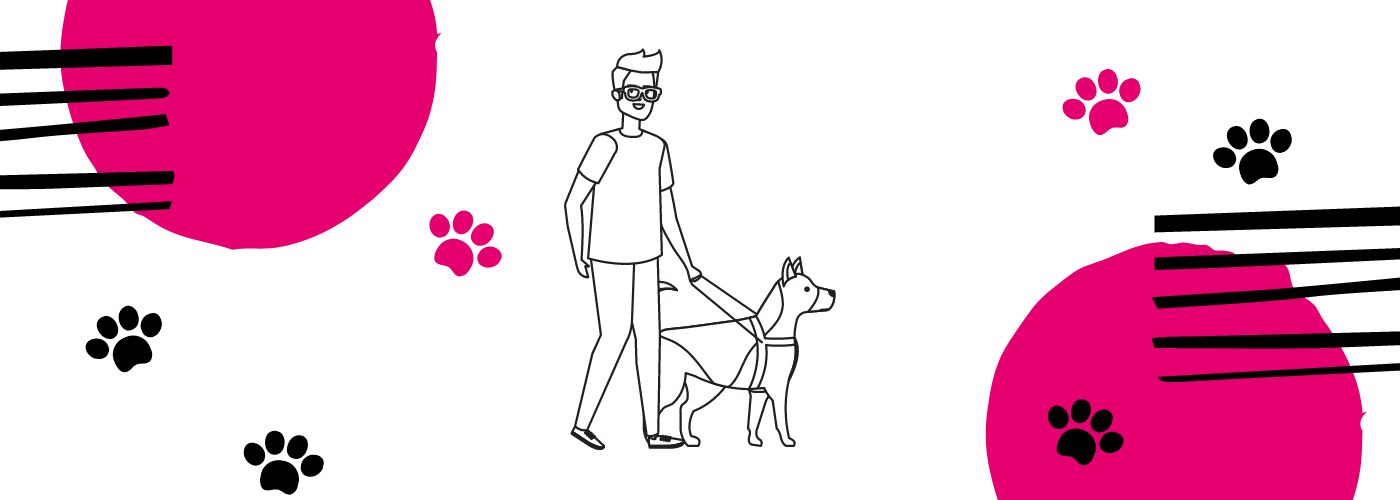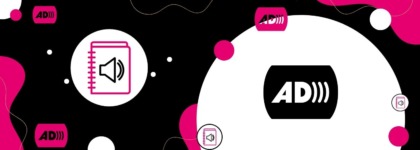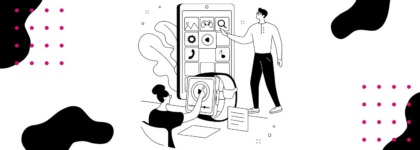What It’s Like to Have a Guide Dog: Interview with Melissa Carney
Every month, we welcome a new guest to 3Play Media’s Allied Podcast. In October 2022, we met with Jacquie Sawyer, Director of Partnerships at The Dogist, and Liz Vacchiano, a regional puppy instructor at Guiding Eyes for the Blind, for the episode “From Puppy to Guide Dog.”
Jacquie and Liz discussed the process of puppy raising, the steps to getting a guide dog, the formal training required, and the impact that guide dogs can have on people’s lives.
In this blog, we’re excited to share the perspective of Melissa Carney, a Guiding Eyes for the Blind graduate, guide dog owner, and Community Outreach and Graduate Support Manager at Guiding Eyes for the Blind.
Interview with Melissa Carney
Can you share some background on your experience in Guiding Eyes and getting a guide dog?
Melissa: I was diagnosed with Retinoblastoma, a rare form of eye cancer, when I was two years old and lost all my sight. However, my parents were passionate about enabling me to pursue the same opportunities as my sighted peers whenever possible. I went to public school using accommodations such as braille, assistive technology, etc.
However, I was the only blind student or student with any physical disability in my school district, therefore disability pride or education did not exist. I was a great student but struggled with figuring out my identity outside of the classroom. My parents introduced me to horseback riding at a young age, one of few fully accessible and adaptable sports, and it was in those experiences that I witnessed the beauty of a bond of trust between human and animal. In that space, I also found pride in my blindness and the ability to be on an equal playing field as my sighted peers. I also loved dogs and was extremely close to my pet yellow Labrador growing up. given both of those factors, I considered applying for a guide dog in high school.
I was invited by my Orientation and Mobility instructor to attend a seminar at Guiding Eyes where I learned some of the differences between using a white cane and guide dog. I was struck by the power of teamwork between guide and handler, even if I only experienced it for a moment. I decided to apply for a guide dog several months before my freshman year of college.
The application typically includes written materials in which we ask applicants a bit about themselves, as well as personal references who can attest to their maturity and responsibility for a guide dog and a reference from an Orientation and Mobility instructor who can speak to their independent travel skills. Vision and medical forms are submitted by appropriate professionals as well. Guiding Eyes politely denied my application after viewing video footage of my route using a white cane, and it was the best decision they ever could have made. They advised me to gain more confidence in my abilities and greater travel experience that would drive my independence.
At that time, my only goal was to receive a guide dog. I didn’t truly realize that half of the confidence, direction, and ambition in every guide dog team must come from the handler. For the next year, I stepped out of my comfort zone. I memorized my college campus, got lost in order to enhance my problem-solving skills, and embraced my blindness and transition to young adulthood. When I applied to Guiding Eyes again in 2016, I was accepted with flying colors. They commended me for the steps I had taken to believe in myself and prepare for a strong partnership with my future dog. I was touched by Guiding Eyes compassion for meeting individuals where they were at and encouraging them to reach their full potential.
In May of 2016, I began training with my match, a yellow Labrador named Aron. We underwent a 3-week residential training program in New York in which we learned how to work with our dogs, including on-harness commands, basic obedience, positive reinforcement tactics, traversing crowded areas, riding escalators, targeting specific locations and objects, and so on. We were exposed to diverse environments, from rural streets with no sidewalks, to the hustle and bustle of Manhattan. We also learned how to care for our guide’s, including regular grooming, veterinary care needs, playtime, and so on. Aron is the type of dog who only forms what I call a “heart bond” with one person at a time, and so he forced me to work for his affection. He made me give my 100%, and in return, he gave me his, which was a 4.0 mile per hour furball of never-ending energy and enthusiasm towards whatever challenges and triumphs life threw at us. He was my perfect match then, and my soulmate guide dog now. He still amazes me each day with the love we share and new adventures we embark on.
How has having a guide dog impacted your life and independence?
Melissa: There is a certain sense of excitement, but also peace, when navigating the world with a guide dog by your side. You are exploring every scenario together, so sometimes you might pick up on something, and sometimes the dog will. The most common misconception about guide dogs is that they function as GPS systems. We work as one team to memorize routes to familiar destinations and map out unfamiliar areas. Aron’s unwavering loyalty, optimistic spirit, and outgoing personality pushed me to extend the realms of what I thought feasible.
About 9 months after receiving Aron, I attended my first convention specifically dedicated to blind individuals and promoting resources and services to support the community. Upon arriving, I quickly realized that I was outclassed in terms of life experience. Most of the people in the convention center had traveled extensively, at least around the Boston area. I specifically remember leaving the banquet room and looking for the elevator. In theory, it is a very simple task, but this was my first time staying at a hotel by myself. I got turned around a few times and started to become frustrated and beat myself up. At one point, I stopped walking, and reached down to pet Aron. Immediately, he burst into tail wags and kisses, as if to say, “Don’t give up yet. We can work together!”
I took a deep breath, picked up the harness handle, and began to create a mental map of the hotel in my mind as Aron and I explored further. He waited patiently as I memorized the various hallways. When we found the elevator, we retraced our steps to the banquet room to solidify the route. Aron then trotted directly to the elevator. We were united in the same goal. That was a simple, yet powerful, example of how we utilized our faith in each other and an unspoken communication to remain calm and motivated until we achieved success.
The “elevator” incident transformed into larger scale challenges, such as flying on a plane for the first time, navigating several giant convention centers, living in Boston and Washington D.C., and taking college classes off campus. Recently, we worked down Bourbon Street in New Orleans, walked the boardwalk of San Diego’s Pacific Beach, and braved the New York subway system. Aron’s faith in me makes me have faith in myself. To this day, Aron looks to me for confirmation, I look to him for loyalty, and we share in the joy of complete understanding.
What was it like being a college student and traveling to classes and around campus with Aron?
Melissa: I attended Mount Holyoke College. I became a much stronger advocate with Aron by my side. I was forced to speak up when students distracted him, when the campus placed trash cans in accessible locations, and even when a professor discriminated against me for bringing a service animal into class. I found my voice in giving him one. In educating others about guide dogs, I also made many amazing friends along the way. My friends and I found opportunities to advocate for greater accessibility on campus.
With Aron by my side, I also felt comfortable taking classes on neighboring college campuses. We commuted twice a week for an entire year, and once again, I had to advocate, this time to figure out if I was on the right bus. As my confidence grew, so did my orientation and thirst to explore new places. My newfound passion for advocacy and love of travel spurred me to participate in two back-to-back internships in 2018, one in Boston and one in DC. There, I discovered that speaking up for myself was not enough, and I wanted to mentor others and support those in my community.
What should other people do when they see someone with a guide dog?
Melissa: There are several rules that they should always follow:
- Do not pet, feed, give direct eye contact and talk to, or otherwise distract a working guide dog. It could put the handler’s safety in jeopardy. A guide dog’s first responsibility is always to their handler, the blind or visually impaired person working with the dog. When in harness, they are constantly navigating around obstacles, indicating objects such as street curbs or stairs, and looking to their handler for commands and direction. As such, it is crucial that a guide dog be able to always focus on their work.
- Do not give the guide dog commands. As the word “handler” implies, the blind or visually impaired person working with the guide dog must have total control over the animal and any situations that arise. Guide dogs and their handlers are carefully matched using factors such as environment, temperament, and pace in order to facilitate a smooth transition to this type of travel. Handlers are taught to use strict commands as they grow comfortable together and establish a bond. It is essential that the dog only looks to the handler for those commands, so they are always on their best behavior while out in public.
- When giving verbal directions, address the handler by name, not the dog. Despite common misconceptions, such as the belief that a guide dog is a GPS and is solely in charge of ensuring the safety of the team, the handler plays an equal part in their relationship and independent travel needs. The handler actively gives directions to the dog, and they both memorize routes to targeted destinations. Both dog and handler communicate through verbal and visual cues to get where they need to go. Give specific directions to the handler, as vague phrases such as “over there” are ineffective at best.
- Do not touch a guide dog’s equipment. This includes both the harness and leash. Just as a handler is the sole caretaker of their guide dog, they should also be the one person with access to the dog’s leash and harness. Only guide dog handlers know the proper use of the equipment issued to them. Attempting to grab the leash or harness can result in confusion for the dog, inability to work, and in some cases, dangerous consequences to the team. For example, guide dog users are trained to listen to surroundings such as traffic flows to determine when it is safe to cross the street, and if you assume they cannot cross streets independently and react by grabbing the dog’s leash, you could put them in harm’s way and distract both members of the team from their decision-making process. Likewise, if you have been asked to assist a guide dog team, you should lead the handler, not the dog. Offer your elbow to the handler so you can guide them, or the handler may choose to direct their dog to follow you. Do not assume that people who are blind and visually impaired are not capable and always need your help.
- Keep your pet under control when passing a working guide dog team outdoors. Your pet may be the friendliest, most social animal in the neighborhood, but all of that is irrelevant when you encounter a guide dog team. Just as you can be a distraction, so can your pet, and in fact, your pet does not recognize whatsoever that the other dog is working. It is your job as a responsible pet owner to prevent your pet from playing with, attacking, or simply getting too close to a working guide dog team. Always keep them on leash. Off-harness, guide dogs love to play, but on-harness, they must remain focused on their work. If your dog has a history of aggression, take extra precautions, as negative interactions can lead to stress and trauma for guide dogs and their handlers.
What sort of support do you provide for other Guiding Eyes graduates?
Melissa: In my role as Community Outreach and Graduate Support Manager at Guiding Eyes, I assist our graduates in resolving access discrimination issues and provide them with tools to advocate, identify key resources for the community and create them accordingly, support handlers through their emotional journeys bonding with their dogs, and plan presentations to educate the public. As a collective effort, Guiding Eyes supports graduates with training issues, veterinary care needs, dog retirement, and so on.
If anyone listening to Allied is interested in getting a guide dog, what resources or programs should they explore?
Melissa: They should think about their own orientation and mobility skills. Do they feel independent and confident with a white cane? Are they aware of the responsibilities of working with and caring for a guide dog? What are the eligibility requirements? A cane is an obstacle detector, while a dog is an obstacle avoider. They are different forms of travel, and there is no one size fits all approach to exploring these avenues. It is based solely on their needs and preferences.
Guiding Eyes offers one of the most comprehensive lists of training options, which include a residential or home-training program, whichever suits your lifestyle, along with a running guides program for athletes, and a Specialized Training Program for individuals with disabilities and/or needs in addition to blindness. Listeners should feel free to contact Guiding Eyes with any questions, no matter where they are in their independent travel journey. We are always happy to support the blind and visually impaired in their endeavors.
Thank you, Melissa, for sharing your story and firsthand experience!
To learn more about guide dogs and puppy raising, listen to the Allied episode below or read the transcript:





